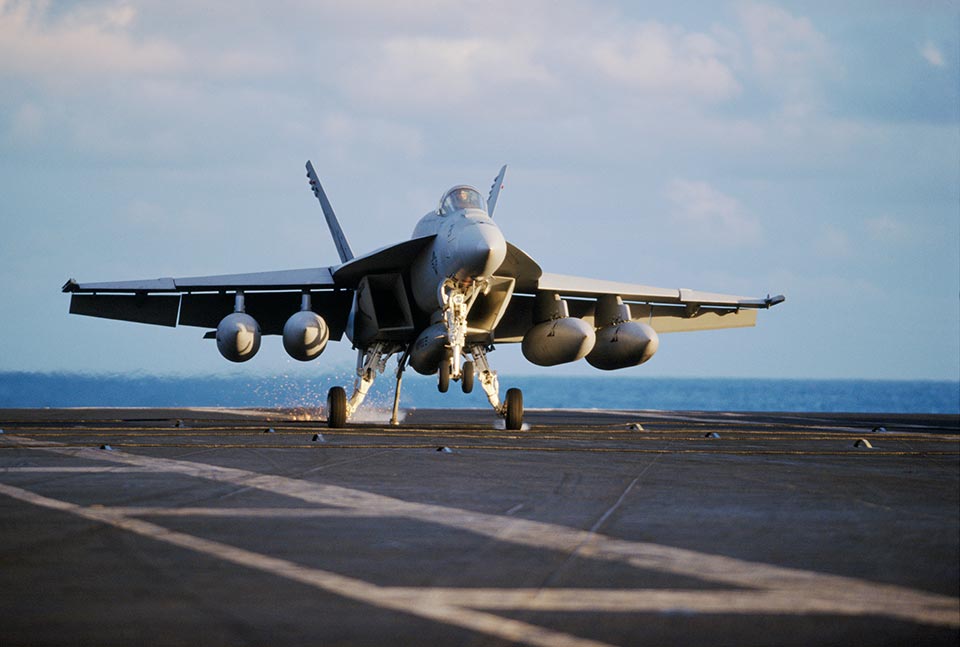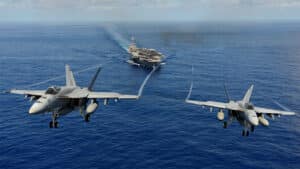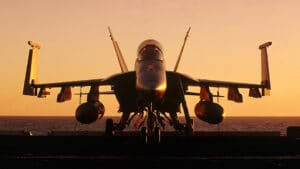Aerospace
These are some of the factors that make the Boeing FA-18 to India a likely strong contender.

The F/A-18 Super Hornet Block III on offer to the Indian Navy is the world’s most advanced, combat proven, multi-role frontline naval fighter that offers unique and differentiated capabilities and full compatibility with Indian Navy carriers.
The F/A-18E/F Block III Super Hornet was designed as a carrier-based fighter for high-load, high-stress operations. It requires little support equipment and has the lowest cost per flight hour to operate with high mission readiness rates. The Block III Super Hornet, being the US Navy’s frontline fighter with over 700 aircraft in service across the world, provides prospects for naval aviation cooperation between the US and Indian militaries. Because it interfaces with assets like the P-8I, the F/A-18E/F Block III Super Hornet can operate as a force multiplier for the Indian Navy.
- COMPATIBILITY OF CARRIER
Both INS Vikramaditya and INS Vikrant are fully compliant.
For carrier lift fitting, a safe and reliable wing-fold option is available.
On deployment, there is no risk of structures (Radome Cone, Wing Tip Rails) being removed.
- INTEROPERABILITY
P-8I interface and other U.S.-origin helicopters, as well as future carrier-based unmanned systems, are enabled by advanced network architecture.
Who will win the Indian Navy’s new fighter jet contract? F/A 18 or Rafale
- VALUE FOR TWO SEATS
The two-seater model is suitable for carrier sorties, as well as land-based missions and training.The Super Hornet is available in single and two-seater versions to the Indian Navy. The two-seater configuration, in particular, will provide the Indian Navy with several distinct advantages, including the ability to meet all missions ashore and on the carrier, increased fleet utilisation, and the ability to successfully complete those missions from the carrier that benefit from having a second crew. Two-seater carrier compatible aircraft will aid the interface between manned and unmanned systems in a carrier environment as the Indian Navy introduces unmanned carrier borne platforms.
- COOPERATION IN NAVAL AVIATION
There are 11 active aircraft carriers, with 700+ F/A-18s. Growlers and Super Hornets in action Opportunities for carrier integration, training, and technology transfer through collaboration. The Indian Navy’s introduction of the F/A-18 Super Hornet would considerably boost naval aviation cooperation, sharing of operational best practises, and interoperability between the two navies, as the US Navy operates over 700 F/A-18 Super Hornets and Growlers. The F/A-18 Super Hornet has the potential to foster collaboration between the two navies in areas such as carrier integration, training, and technology transfer, among other things.
- INDIA FOR INDIA’S SUSTAINABILITY
Optimize India Services expertise to boost mission readiness, availability, and competitive lifecycle costs by leveraging scale and efficiency with the common LCA Tejas engine family.
What is the Boeing P-8I in the Indian Navy used for?
- SKI-JUMP LAUNCH
Boeing and the US Navy demonstrated the F/A-18 Super Hornet’s ability to operate off a “ski jump” ramp in December 2020, confirming the aircraft’s potential for India’s aircraft carriers. The experiments, which took place at Naval Air Station Patuxent River, MD, demonstrated that the Super Hornet would work well with the Indian Navy’s Short Takeoff but Arrested Recovery (STOBAR) technology and backed up previous Boeing simulations.
Mind blowing facts about US Navy F/A 18 super Hornet fighter jet
- 10,000- HOUR LIFE SPAN
The airframe has a 10,000-hour life span. This means it has a long lifecycle built in for future upgrades and enhancements, and depending on the Indian Navy’s needs, our ‘By India – For India’ sustainment programme, which is based on other successful sustainment programmes that Boeing is currently executing for the Indian Air Force and the Indian Navy, will enable India to develop capabilities to sustain the F/A-18 Super Hornet.
Boeing signs pact to make F/A-18 Super Hornet fighter jets in India

Aerospace
India is set to build a central command for the Air Traffic Control system, called ISHAN

India’s air traffic growth has led to increased responsibilities for air traffic control. The Airports Authority of India (AAI) is considering centralizing air traffic control for aircraft, dividing the country into four regions. The goal is to consolidate India’s segmented airspace into a single entity to improve air traffic management (ATM) efficiency, safety, and smoothness.
Recently, the AAI invited expressions of interest to develop a detailed project report for the Indian Single Sky Harmonized Air Traffic Management (ISHAN) initiative in Nagpur. Under this plan, air traffic controllers in Nagpur would handle domestic flights flying above 25,000 feet, eliminating the need for coordination among controllers in different regions.
For domestic regional flights operating above 25,000 feet, control would shift to the central command in Nagpur. This consolidation aims to enhance airline operations, increase flight handling capacity, and reduce congestion and flight times for passengers.
Currently, the AAI provides ATM services over Indian airspace and adjoining oceanic areas, covering over 2.8 million square nautical miles. This airspace is divided into four flight information regions (FIRs) in Delhi, Mumbai, Kolkata, and Chennai, along with a sub-FIR in Guwahati.
FIRs are responsible for providing air traffic services, including weather information, visibility, and search and rescue assistance. The proposed unification under the ISHAN initiative aligns with the projected growth of the aviation industry, which anticipates a doubling of domestic passenger traffic by 2030.
Aerospace
Does AirAsia show interest in Comac aircraft in the future?

Tony Fernandes, CEO of Capital A, operating as AirAsia Group, recently paid a visit to the facilities of COMAC on April 2, 2024, and was thoroughly impressed by what he witnessed.
C919 already securing nearly 1000 orders
COMAC, known for its homegrown aircraft, has launched two promising jets: the ARJ21 and the C919 aircraft. Both aircraft are gaining popularity in the Chinese market, with the C919 already securing nearly 1000 orders from various airlines.
Fernandes expressed his admiration for COMAC’s achievements in aircraft manufacturing, acknowledging the immense challenge it entails. His visit underscored the realization that AirAsia now has a viable third option when it comes to selecting aircraft for its fleet.
During his tour, Fernandes was delighted by the innovation and technology evident in COMAC’s aircraft production and the company’s commitment to long-term partnerships.
He noted that many Western companies have shifted away from prioritizing loyalty and customer service, opting instead for short-term gains and a narrow definition of success.
Last month, COMAC embarked on an international tour, showcasing demonstration flights to neighboring countries, particularly Indonesia and Malaysia. Fernandes believes that the positive impression left by COMAC during his visit opens up new opportunities for collaboration.
Fernandes emphasized COMAC’s remarkable achievements
The shared values of loyalty, customer service, and long-term vision align closely with AirAsia’s ethos, making collaboration with COMAC appealing. With a focus on innovation and excellence, both companies stand to benefit from a partnership grounded in trust and a shared commitment to success.
Indonesia and China have already collaborated in validating and maintaining the airworthiness of the ARJ21 aircraft, indicating a solid foundation for future partnerships.
In his statement, Fernandes emphasized COMAC’s remarkable achievements and genuine desire for long-term partnership, highlighting the absence of ego and a genuine willingness to succeed together. He marveled at COMAC’s fully automated, AI-driven factory, a testament to their dedication to innovation and efficiency.
Fernandes criticized Western firms for prioritizing short-term gains over loyalty, customer service, and long-term strategy, emphasizing the importance of understanding customers’ needs and collaborating to achieve success.
Aerospace
Indigo will soon launch Air Taxi Service in India

InterGlobe Enterprises, the parent brand of IndiGo, is set to revolutionize travel in India with its upcoming air taxi service.
Scheduled for a potential launch in 2026, this innovative venture promises a seamless journey for passengers between two bustling hubs. Delhi and Gurgaon in Haryana. The forthcoming service is projected to revolutionize the daily commute, offering passengers a swift aerial journey covering the distance in a mere 7 minutes.
This remarkable efficiency contrasts starkly with the conventional 90-minute drive, underscoring the immense time-saving potential for commuters. The anticipated fare, ranging from Rs 2,000-3,000, makes this innovative mode of transport not only swift but also remarkably competitive in pricing.
At the heart of this ambitious endeavor lies a strategic partnership with Archer Aviation, a pioneer in electric vertical takeoff and landing (eVTOL) aircraft technology. Under this collaboration, Archer will supply 200 state-of-the-art eVTOL aircraft, representing an investment of US$ 1 billion. These cutting-edge aircraft, capable of accommodating up to four passengers alongside the pilot, epitomize the future of sustainable air travel.
Powered by six battery packs, Archer’s eVTOL aircraft boast rapid charging capabilities, enabling a swift turnaround between flights. With a charging time of just 30-40 minutes, these eco-friendly aircraft ensure minimal downtime, maximizing operational efficiency.
Similar services are anticipated to be introduced by the joint venture in Bengaluru and Mumbai as well. Nevertheless, the service rollout period has not yet been made public by the company. Next year, it is anticipated to get its certification. Following this, the company will start the certification procedure with the Directorate General of Civil Aviation (DGCA).



























